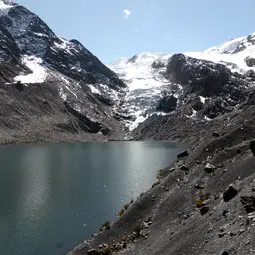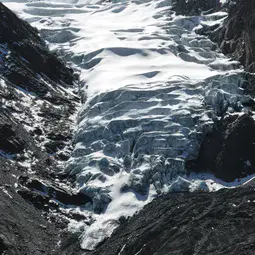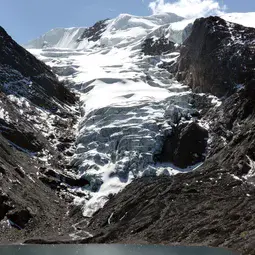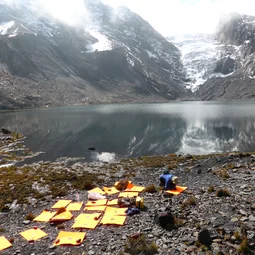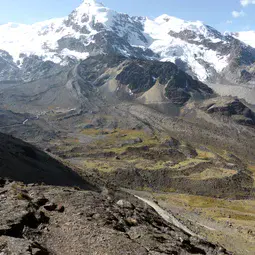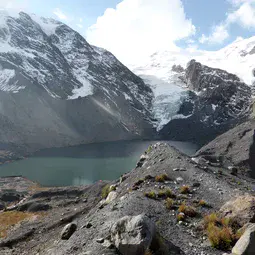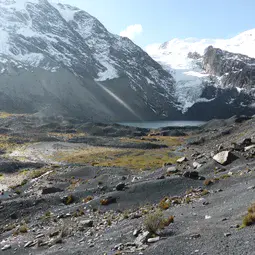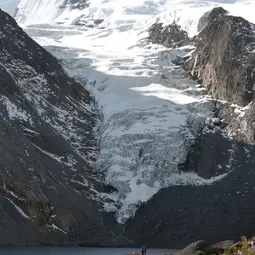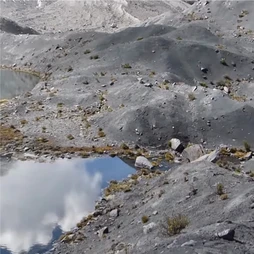Receding glaciers in Bolivia leave communities at risk
A new study published in The Cryosphere, an European Geosciences Union journal, has found that Bolivian glaciers shrunk by 43% between 1986 and 2014, and will continue to diminish if temperatures in the region continue to increase. “On top of that, glacier recession is leaving lakes that could burst and wash away villages or infrastructure downstream,” says lead-author Simon Cook, a lecturer at the Manchester Metropolitan University in the UK.
Receding glaciers also put water supply in the region at risk. Glacial meltwater is important for irrigation, drinking water and hydropower, both for mountain villages and large cities such as La Paz and El Alto. Throughout the year, the 2.3 million inhabitants of these two cities receive about 15% of their water supply from glaciers, with this percentage almost doubling during the dry season. Glacier retreat also means less water is available to supply rivers and lakes, such as southern Bolivia’s Lake Poopó, which recently dried up.
The new study is one of the first to monitor recent large-scale glacier change in Bolivia, to better understand how receding glaciers could affect communities in the country. “The novelty of our study lies in the bigger picture – measuring glacier change over all main glaciated ranges in Bolivia – and in the identification of potentially dangerous lakes for the first time,” Cook says.
The team measured glacier area change from 1986 to 2014 using satellite images from Landsat, the U.S. Geological Survey’s and NASA’s Earth observation programme. They found that the area of the Bolivian Andes covered by glaciers decreased from about 530 square kilometres in 1986 to only around 300 square kilometres in 2014, a reduction of 43%.
As glaciers recede, they leave behind lakes typically dammed by bedrock or glacial debris. Avalanches, rockfalls or earthquakes can breach these dams, or cause water to overflow them, resulting in catastrophic floods known as glacial lake outburst floods. The team reports that both the number and size of glacier lakes in the study region increased significantly from 1986 to 2014.
After studying glacier change, the researchers used their 2014 glacial-lake observations to identify the lakes where outburst floods could occur and present a hazard to populations. “We mapped hundreds of lakes,” Cook explains. “Some lakes are very small and pose little risk. Others are very large, but there’s little or no possibility that they would drain catastrophically. Others are both large enough to create a big flood, and sit beneath steep slopes or steep glaciers, and could be dangerous.”
They identified 25 glacial lakes across the Bolivian Andes as potentially dangerous to communities and infrastructure, as they could result in very damaging floods. If the smallest of these 25 lakes was to drain completely, it would yield a flood with a peak discharge of 600 cubic metres per second. The largest could result in a discharge of over 125,000 cubic metres of water, about 50 times the volume of an Olympic swimming pool, in a second.
While measuring glacier area change was a relatively simple task, Cook says “identifying which lakes are dangerous is the million dollar question” as there are various factors to take into account.
“We considered that a lake was dangerous if there were settlements or infrastructure down-valley from the lake, and if the slopes and glaciers around the lake were very steep, meaning that they could shed ice or snow or rock into the lake, which would cause it to overtop and generate a flood – a bit like jumping into a swimming pool, but on a much bigger scale!”
Such catastrophic floods have occurred in the region in the past. Dirk Hoffmann, a researcher at the Bolivian Mountain Institute and co-author in The Cryosphere study, recently documented a glacial lake outburst flood in the Apolobamba region that happened in 2009 and killed farm animals, destroyed cultivated fields and washed away a road that left a village isolated for months. “As those locations are very remote and far away from the cities, authorities at national level and the wider public are often not even aware of the new dangers that mountain dwellers are facing due to the impacts of climate change, and no appropriate measures are being taken,” Hoffmann says.
Cook says these events could be under-reported, suggesting the risk of such floods in the Bolivian Andes has been overlooked. “We heard of other [glacier lake outburst flood] events from villagers when we visited the Apolobamba region in 2015, but there is no mention of these in publications or papers, possibly because many of these communities are relatively remote.” Hoffmann adds: “A nation-wide risk assessment of potentially dangerous glacial lakes would be of great interest to local communities in glacier watersheds.”
In the study, the team also estimated that glacier area will be severely reduced by the end of the century, to about a tenth of the 1986 values. This would put communities even more at risk from water scarcity, Cook says. “We predicted in our study that most glaciers will be gone or much diminished by the end of the century – so where will the water come from in the dry season? Big cities like La Paz are partially dependent on meltwater from glaciers. But little is known about potential water resource stress in more remote areas. More work needs to be done on this issue.”
The team hope the study raises awareness about the rapid glacier loss in Bolivia, how it could change in the future, and how it could affect water supply and cause glacial lake outburst floods. “Ultimately, I hope that our results will be useful to people in Bolivia – governments, agencies, people living in rural areas and cities,” Cook concludes.
###
Please mention the name of the publication (The Cryosphere) if reporting on this story and, if reporting online, include a link to the paper (http://www.the-cryosphere.net/10/2399/2016/) or to the journal website (http://www.the-cryosphere.net).
More information
This research is presented in the paper ‘Glacier change and glacial lake outburst flood risk in the Bolivian Andes’, published in the EGU open access journal The Cryosphere on 20 October 2016.
Citation: Cook, S. J., Kougkoulos, I., Edwards, L. A., Dortch, J., and Hoffmann, D.: Glacier change and glacial lake outburst flood risk in the Bolivian Andes, The Cryosphere, 10, 2399-2413, doi:10.5194/tc-10-2399-2016, 2016
The team is composed of Simon J. Cook (Manchester Metropolitan University [MMU] and Cryosphere Research at Manchester [CRAM], UK), Ioannis Kougkoulos (MMU and CRAM), Laura A. Edwards (CRAM and University of Manchester), Jason Dortch (CRAM and University of Manchester), and Dirk Hoffmann (Bolivian Mountain Institute).
The European Geosciences Union (EGU) is Europe’s premier geosciences union, dedicated to the pursuit of excellence in the Earth, planetary, and space sciences for the benefit of humanity, worldwide. It is a non-profit interdisciplinary learned association of scientists founded in 2002. The EGU has a current portfolio of 17 diverse scientific journals, which use an innovative open access format, and organises a number of topical meetings, and education and outreach activities. Its annual General Assembly is the largest and most prominent European geosciences event, attracting over 11,000 scientists from all over the world. The meeting’s sessions cover a wide range of topics, including volcanology, planetary exploration, the Earth’s internal structure and atmosphere, climate, energy, and resources. The EGU 2017 General Assembly is taking place in Vienna, Austria, from 23 to 28 April 2017. For information about meeting and press registration, please check http://media.egu.eu, or follow the EGU on Twitter and Facebook.
If you wish to receive our press releases via email, please use the Press Release Subscription Form at http://www.egu.eu/news/subscribe/. Subscribed journalists and other members of the media receive EGU press releases under embargo (if applicable) in advance of public dissemination.
The Cryosphere is an international scientific journal dedicated to the publication and discussion of research articles, short communications, and review papers on all aspects of frozen water and ground on Earth and on other planetary bodies. The main subject areas are ice sheets and glaciers, planetary ice bodies, permafrost, river and lake ice, seasonal snow cover, sea ice, remote sensing, numerical modelling, in situ and laboratory studies of the above and including studies of the interaction of the cryosphere with the rest of the climate system.
Contact
Simon Cook
Senior Lecturer in Physical Geography
School of Science and the Environment, Manchester Metropolitan University
Phone +44 (0)161 2471202
Email s.j.cook@mmu.ac.uk
X @glacio_cook
Dirk Hoffmann
Coordinator and Senior Researcher
Bolivian Mountain Institute
La Paz, Bolivia
Phone +49-1522-4115439 (at a conference, email contact preferred)
Email dirk.hoffmann@bolivian-mountains.org
Bárbara Ferreira
EGU Media and Communications Manager
Munich, Germany
Phone +49-89-2180-6703
Email media@egu.eu
X @EuroGeosciences
Links
- Scientific paper
- Journal – The Cryosphere
- Read this release in Spanish
- Read this release in Greek
- Read this release in French
- Read this press release in simplified language, aimed at 7–13 year olds, on our Planet Press site


